Saving Channel Drive’s Walking/Bicycling Path
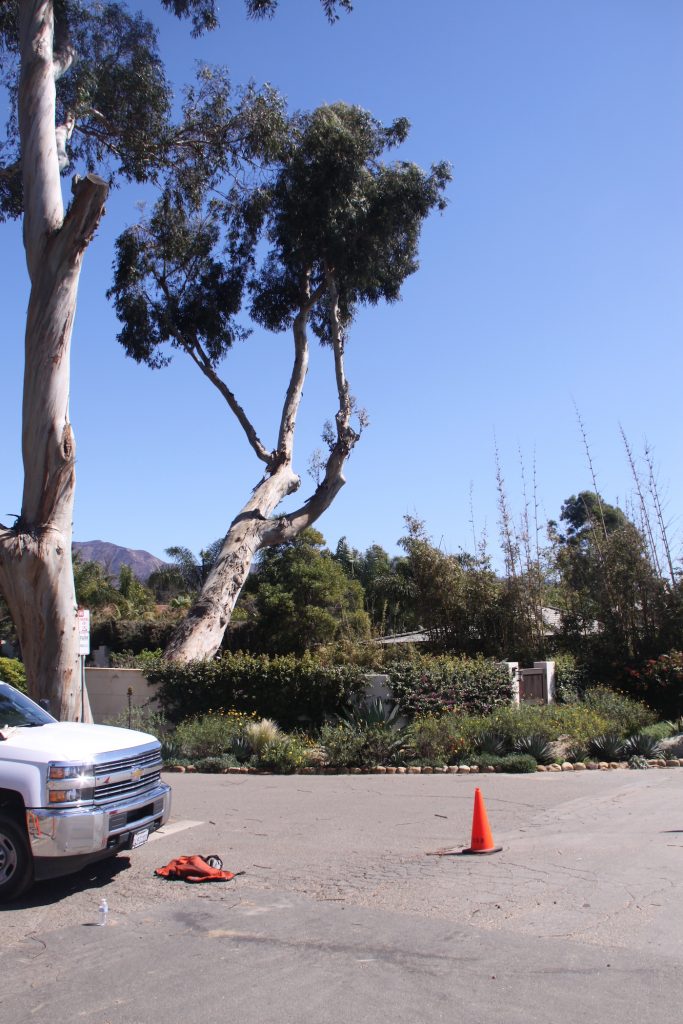
Montecito‘s bike and walking paths are slipping into the ocean. Recent heavy rains are eroding the bike path’s retaining wall along Channel Drive. The path is now dramatically undermined; easily viewable from the beach. In various areas, huge sections of retaining cement walls, mounds of cliff-side mud and trees litter the sand.
This week, a eucalyptus fell to the beach, breaking another section of a retaining wall, which was protecting a main storm drain. Several large palms also look ready to fall, with their roots largely exposed and no soil underneath them for support. Meanwhile, the number of encampments and camp fires – people living under the cliff. If you go down there, notice the two campfires and also the large third fire on the hillside of the bamboo. At 6:30 am, when I go, there are always multiple tents and sleeping bags set up.
Jane Wood Orfalea
Montecito
(Editor’s note: Matt Dobberteen, with SB County Public Works, responded to Ms Orfalea’s above note quickly and definitively. “I will get a crew out to assess this immediately,” he wrote via email and followed up by informing Jane that he was “working with the Coastal Commission today,” but that he would “give them a heads up that we may need an emergency permit.” The next day, crews were out removing the trunk and concomitant debris from the downed tree. It’s good to see that someone with authority can and does respond in such a timely fashion.
I went out and snapped the accompanying photos, and as you can see, where there once (about three years ago) were five giant eucalyptus trees at the northwest corner of Channel Drive and Butterfly Lane, there are now but two. Fortunately for all, when those trees came down there was no one walking or bicycling in harm’s way. But, if those two eucs still standing are not taken down soon, there’s no telling who or what will be underneath as they come crashing to the ground.
Additionally, across the way, on the northeast corner, there is another rather large euc leaning precipitously behind the fence on the parcel that, when it too comes down – as it will – is likely to land squarely on the roof of the house on the property. What Montecito needs is to dispatch an EDT (Eucalyptus Demolition Team), paid for with county funds and manned by county employees to bring down any and all eucalyptus trees on roadways and public land that pose a danger to vehicles and humans. It would be money well spent. – J.B.)
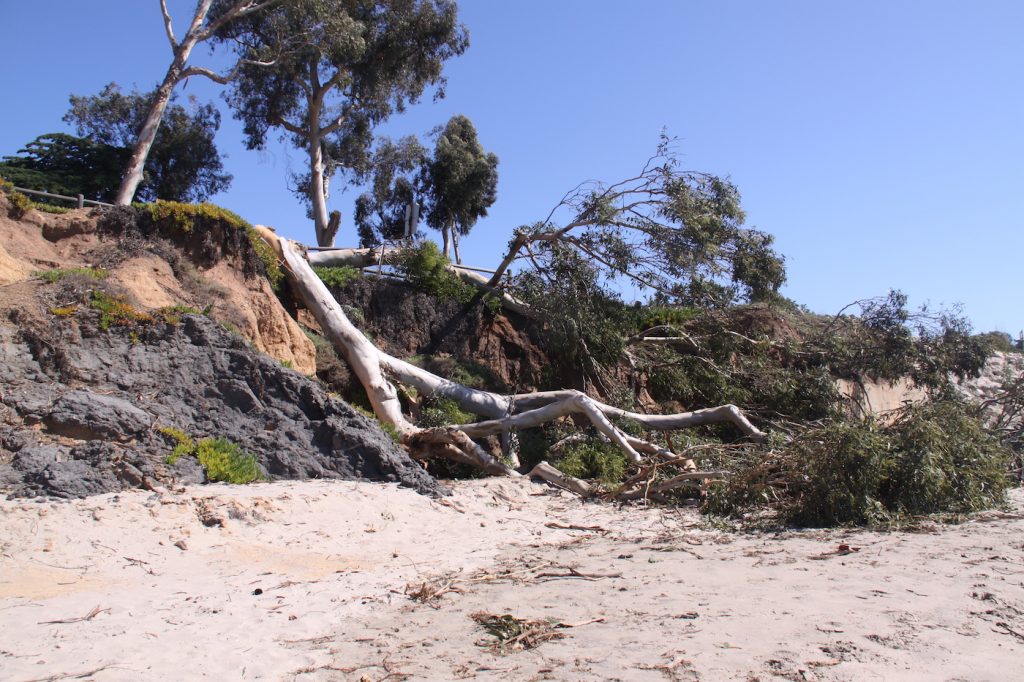
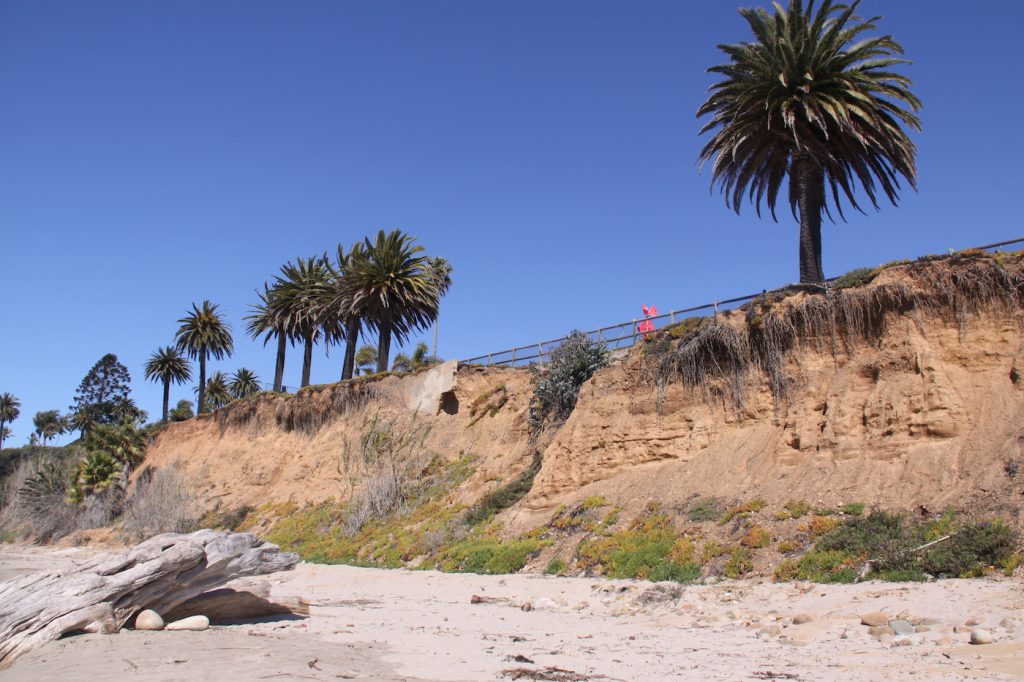
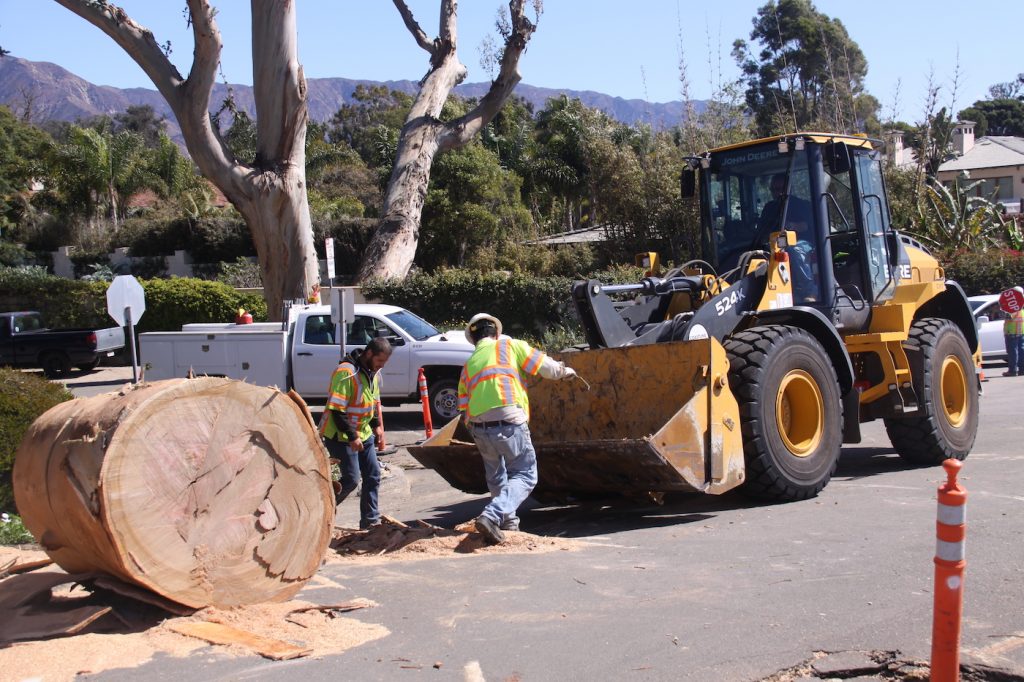
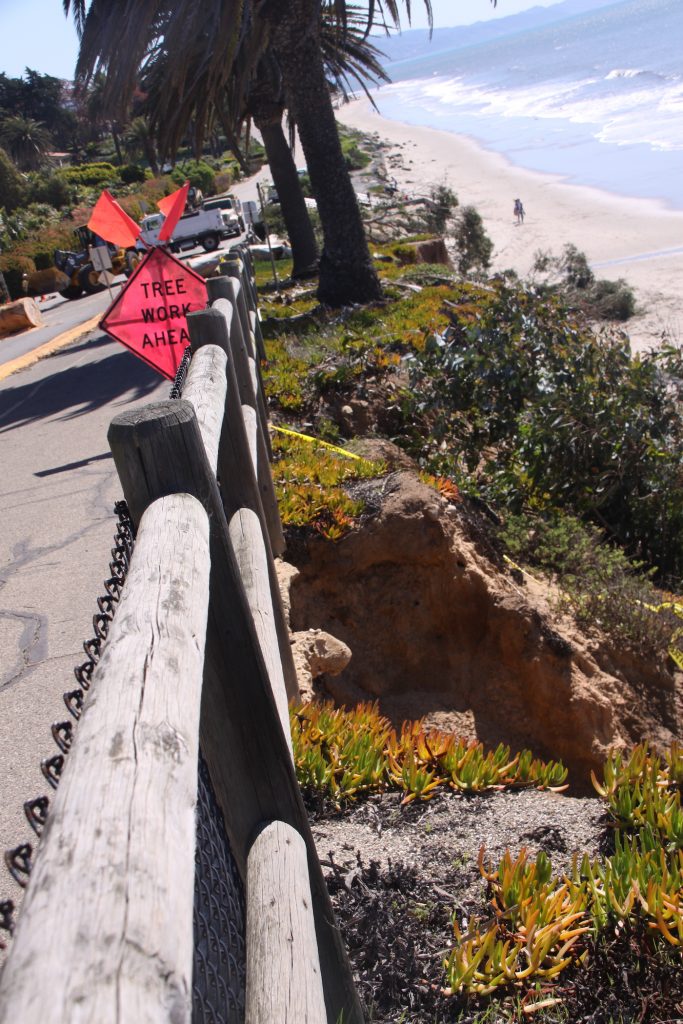
There is no land left under this section of the Channel Drive pathway; one more storm and it too is likely to be washed away 
There were five large eucs standing here not long ago; two came down the same night a little over a year ago, and the middle one just fell this week; the other two will fall soon enough
A Better Montecito?
I’m writing you in between evacuations to say I wholeheartedly agree with your recent editorial proposing that it’s time to take advantage of the horrific event of 1/9 to tackle the four redevelopment priorities you named (“A New Montecito,” MJ #24/10). One concern I have is, who would lead this monumental charge… and when?
Secondly, lofty goals inevitably take considerable time to navigate through the bureaucratic approval arena. Meanwhile, Montecito will be in need of immediate design decisions, direction, and leadership for solving problems. My fear is that unless we as a community are prepared to unite immediately (Montecito Association?), things will soon be subject to outside politicians, bureaucrats, and budgets.
Just two weeks ago, our local news station interviewed SB County architect Bob Ooley standing at the devastated triangle intersection of Olive Mill and Hot Springs roads proposing a roundabout.
As a planner and landscape architect for 35 years, I know how fashionable roundabouts have become in planning communities.
However, they are designed to move cars more expeditiously thru intersections and inevitably encourage larger traffic loads. They require more space, bright lighting (in a Dark Sky community!), and restrict the amount and variety of landscaping. Also, because the focus is on the automobile, pedestrian safety is compromised. You need only walk or ride a bike around the Hot Springs/Coast Village Road roundabout to see how intimidating it is.
It was shocking that a spokesman for the county would already be proposing a roundabout in one of the few Montecito open spaces without any apparent consideration to the pastoral setting or community input for other opportunities.
Mr. Ooley’s idea might never be implemented, but it’s an example of where others less affected by our disaster are already looking at opportunities to redesign our community. This is the first instance of a proposed “restoration” that is more a “reinvention.”
I’ve worked on many communities worldwide. Soon after establishing design principles and guidelines, some force invariably attempts to adjust or ignore them. Over time, change is inevitable and improvements necessary. But they should always be directed by original design principles and the involvement of the stakeholders.
You mentioned that San Francisco’s and Santa Barbara’s early-20th-century earthquake disasters had been an opportunity to develop architectural-landscape architectural guidelines to define a vision for the future. Fortunately, however, Montecito doesn’t need to be reinvented. Its unique beauty, known throughout the world, has been well-established for over a century. We as stewards only need to protect and preserve it.
We’ve lost enough and can’t take anything for granted. We as stakeholders must be vigilant and get involved now to preserve and build on the legacy of Montecito, the place we so fortunately and blessedly call home.
Mark Lorge
Montecito
(Editor’s note: 1) You should know there are many such as yourself who worry about being dictated to by a bunch of bureaucrats who know little or nothing about Montecito, and some are likely to come forward over the next few months. 2) A proposed roundabout at the Hot Springs-Olive Mill triangle is just about the dumbest idea we’ve heard so far, so you are correct in not only worrying about what may or could happen if Montecito residents don’t step up and wrest control of the conversation, but in wanting to do something about it. Right away. We and many others are on it. – J.B.)
Saving the Woodland
I recently attended a meeting with my neighbors on my lane. Our 12 homes are all on the western side of San Ysidro Creek or watershed and none are back in our homes following the 1/9 event; most never will be. I supposed the meeting would be focused upon evacuation, mud removal, and insurance adjuster stories. It was not. Rather, the group discussed the exceptional 44-acre woodland at the end of our lane and what could be done to save it from the certain result of the mud and debris assault.
Ennisbrook is the owner of the woodland. In 1989, it granted to the Land Trust for Santa Barbara a conservation easement to the property. Together, Ennisbrook and the Land Trust pledged to preserve and protect in perpetuity the trees and associated habitat, which includes “ a diverse population of native plants, birds, mammals, and a monarch butterfly preserve” for all to enjoy. The Land Trust in turn engaged the Montecito Trails Association to maintain walking trails, enabling us to experience and enjoy this wonderful gift.
Should there be any good news associated with this crisis, it is this; the parties overseeing this woodland are all neighbors and people we know, and I believe fully intend to do everything possible to save this community treasure.
Unfortunately, the scope of the damage is massive, and the cost necessary to save this habitat is certain to be significant. In addition, the necessary cooperation required to act quickly enough to save this habitat will be challenging.
Our lane continues to engage with Ennisbrook and the Land Trust to help find a solution. Should you be in a position to assist the parties in this urgent effort, time is of the essence. The extraordinary Bucket Brigade volunteers have been actively digging out oaks and significant sycamores at the site in hopes of freeing critical root zones before they suffocate and are lost. They are always looking for new backs, and there is much to do.
Michael Phillips
Montecito
No More Monsters
I’m submitting this in the faint hope that it will foster a common ground that both sides could agree on, although I do have my doubts, regarding mass shooters. Except for a very small percentage of the population, we are not born as natural-born killers. A killer is made, not born. Therefore, if the goal is truly to do something about mass shooting, rather than enacting yet again another law to ban something, focus on factors that produce a mass shooter. Mass shooters have several traits in common:
1) The shooter had a troubled childhood;
2) Was raised in a single-parent household (think single or divorced mom) where the child’s father was either absent or abusive;
3) The child was prescribed psyche meds to make him more controllable (ADD, depression, anxiety);
4) The now-teenager, in addition to all the usual items that make being a teenager years a pain in the butt, has a history of poor social/conflict resolution skills, which fuels a rage against every one else and resentment against everyone around him, turning him into an outcast or a loner;
5) He lives in a cultural and society that sends very mixed messages about violence. Think of our entertainers, who call for gun control, yet make millions in movies with that same actor, shooting people without consequence and being a hero for doing so;
6) Thanks to feminism, being a normal male is viewed as abnormal, deviant behavior and labeled as “toxic.” Males are expected to become more and more effeminate. Also, there is not a “rite of passage,” where a young male under goes to become a “man.” The very notion of being a “man” as a social construct is mocked. Our culture once had “heroic” both in real life, historical, and in our common entertainment men who, demonstrated the qualities, virtues, and a standard of behavior. Traditional manhood is being replaced with a gender-neutral, confused wimp (soy boi), or a parody of the worst traits take to an extreme (inner-city gangsta thug);
7) Another trait in common with mass shooters: they were non-religious. I don’t know of any who attended a church regularly. Having a belief in a much higher authority than yourself, to whom you will have to answer to for your actions and conduct in this life, does strongly curb one’s impulses.
If we want to stop mass shooting, then stop creating the monsters that do such deeds.
Larry Bond
Santa Barbara
Getting Together Again
All of us in The Recovery Project and at the Recovery Free Store are deeply grateful for your story (“Recover We Will,” MJ #23/12) which was so complete and covered so many of our people, all of whom have dedicated tremendous time and effort and continue to do so.
In ramping up in our community outreach, yesterday I visited with Dr. Jeffery Kupperman a well-known pulmonary specialist in Santa Barbara. He is very concerned about the amount of Valley Fever and other spore-borne diseases brought up by the recent debris slide and the increased rate of occurrence in our area. He feels the community is not as aware and proactive as needed. In fact, he and another local specialist will be speaking to the national association of pulmonary specialists on this subject next week. This might be an extremely important subject for you to bring to the attention of our community. I, for one, have not seen it covered with appropriate information on a protocol for us to adhere to.
Again, we can’t thank you enough. As you know, we were supported by a full-page ad in the Journal provided by Susan St. John, one of our angels. It was a tremendous help to our effort, but your article has surely brought the store to the attention of many people who need us, especially for the startup of our habitat drive. So, we now consider you one of our angels too!
We have started to create events presented by the Recovery Project for our community. The first one, Woman’s Community Night, is Thursday, March 29, beginning at 7 pm at the Recovery Free Store, 1016 Coast Village Road (across from Vons). We are taking reservations (call 805-570-4339) since space is limited.
Berna Keiler
Montecito
Dropping out and Dropping In
In last week’s issue, Michael Sanchez wrote (“Smugness on Parade,” MJ #24/12): “But many of those big-name actors who started as children often don’t even have a high school education. And yet, they somehow feel qualified to tell the rest of us what we should think and sometimes even how to vote.”
Does that mean the more than 1.3 million people who drop out of high school every year in the U.S. should put a cork in their mouth?
What about college dropouts? Are the one out of 15 U.S. millionaires who drop out of school allowed to have a political opinion?
What about billionaire Kirk Kerkorian? He dropped out of the eighth grade.
Our public school system — first enforced in the U.S. at gunpoint — is more about brainwashing than education.
It originated in ancient Sparta, and was fine-tuned in the 19th century in both class-conscious Prussia and caste-conscious India.
John Dewey wrote (in 1897), “Every teacher should realize he is a social servant set apart for the maintenance of the proper social order and the securing of the right social growth. In this way, the teacher is always the prophet of the true God and the usherer in of the true kingdom of heaven.”
Incidentally, there is an underlying, snooty overeducated vibe in Hollywood. Many “Hollywood” notables received their pre-college education in elite private schools.
Dick Wolf went to Andover and also attended two other elite schools: The Gunnery, founded in 1850, and St, David’s School, opened in 1951. James Spader dropped out of Andover, while Humphrey Bogart and Jesse Colin Young were expelled. Bruce Dern, Sir Michael Lindsay-Hogg, and Ben Kurland dropped out of Choate.
Long story short, I’ve got no problem with dropouts such as actor Armie Hammer of Montecito voicing his political views.
Our Eden By the Sea has come a long way, baby, since Montecito residents allowed actor Robert Mitchum to join the Birnam Wood Country Club.
My hero is actor/comedian Buster Keaton, who was kicked out of school for good on the same day he was forced to go to school.
I admire people who can roll big wheels without any coerced education, such as admiral David Farragut (1801-70), who took command of his first warship when he was 12 years old.
Atom Bergstrom
Montecito
Deer Grammarians
When, in the great topological tumble, 20-ton boulders come crashing through entire communities, they nudge us toward contemplating, as do the interpenetrating planes of Cubist paintings, the structurality of structure. After all, we find ourselves suddenly left living and thinking within a Buddhist teaching: that all realms interpenetrate. And it is not only boulders. As a nun at the Vedanta Temple recently confessed: Neighbors who may never had met, when stranded from civilization, found themselves hiking to each other’s doors and extending welcoming and helping hands.
All realms interpenetrate, and each realm has its own story, within which abides its own deep grammar and mythos. The story of the mountains for instance, is mostly silent, for they begin to mouth their deep, geomorphic grammar lessons only when their boulders begin clearing their throats in their streambeds. How well do we read it?
The deer grammarians, could they but share with us their stories, would inform us that in the Great Forest, all forest beings — 2,000-year-old trees, waterfalls, fierce mountain lions, members of their own herd — are all mere nouns. That in the entire Great Forest, there exists only one verb. One power capable of significant action.
“Fire” is the name of that verb. As in firing a clay pot, or a province.
Fire roars, laying down the laws proclaiming the deep grammar of the forest. All the other beings in the forest must yield to Fire’s irresistible message, the transforming energy flow that is the forest’s metabolism. All other beings are merely passive agents: food for fire’s millions of voracious mouths. Fire is born of the forests. The Child of the Forests, as Indo-European pastoralists called him. In his infancy, the mothering trees embrace him, desiring him who desires them. He clings to the trees with his blazing lusters, like a fawn drinking from a doe. Born of the trees, he yet devours them in a second. He is terrible, irresistible, and tears the forests apart. Wide-spreading: his light is seen from afar. When driven by wind, he tears asunder Earth’s body, licking the young Earth as the master of her treasures. All the beings of the forests have for so long lived circumscribed by his laws that fire is inscribed within the very laws of their own being.
Many species of pine seeds do not germinate until liberated from their imprisoning cones by the touch of fire. Redwood seeds flourish in ash beds left by the burning of a decayed giant. In primitive coniferous forests, large and unnatural accumulations of dead wood did not develop. This is because light burns, like the herds themselves, roamed freely through the forests, keeping them open and clean, enriching the soil, and encouraging the growth of herbaceous plants.
These created, in effect, huge salads. Primordial, park-like forests were inviting to deer. Deer populations, post-burn, exploded. After rains, deer would drink in swollen streams and pasture on successive waves of post-fire vegetation bathed in un-shadowed sunlight. This gave two-footed creatures, who followed the four-footed, freedom to rove the groves of oaks and pines and to hunt and to gather acorns and pine nuts.
Deer, however, do not dwell in fixed abodes. They could escape blazes in the patchwork quilts of primitive but open forests simply by stepping into recently burned patches of ground. They did not have to contend with what Forest Service folk call “downstream values”: the fixed structures erected by civilizations.
It is easy to see that each fire and debris victim, homeowner, banker, real estate worker, emergency responder, and Caltrans and Amtrak exec harbors a story that paints fire in a different light. How to reconcile these two conflicting discourses and the actions that flow from them?
Gary Snyder, lauded as poet laureate of Deep Ecology, has long advised designing with nature. In The Politics of Ethnopoetics, he suggests that in designing our homes and communities, we learn natural-law design principles by studying the myths and other “texts” of tribal peoples: the Chumash, for instance, as detailed in Patterns of Indian Burning in California: Ecology and Ethnohistory (Henry T. Lewis). How to design like pre-colonial Chumash? By reflecting on Snyder’s advice to realize that Nature is not a place we visit, but where we live.
After the Coyote Fire, a story emerged of a couple who, when beholding the flames approach, donned their scuba gear, slipped into their swimming pool, and chilled until things cooled down. Knowing that chaparral is the fiercest of fuels, they had constructed their dwelling from concrete.
The scriptures of the Indic branch of the Indo Europeans proclaim (listen up insurance and mortgage companies, as well as all those who want to rebuild): “Fire is the close comrade of the Rivers, as is a brother to his sisters.” If you fly over Italy, you will behold old towns built on hills, with the rich alluvial valleys reserved for agriculture.
In closing, I wonder aloud if in the continuing whisper of Montecito stories of the Great Flow, is there one utterance that serves, in the words of Borges, as “the formula and perfect compendium of all the rest”? Is there one overarching deep grammar that harmonizes all the others?
I have heard that voice reverberating in the actions of all those I have observed responding to Montecito’s recent tragedy by performing nameless and perhaps unremembered little acts of kindness and of love, day after day: from disaster center workers, the responders, the Bucket Brigade, the crew at the free-clothing store, and countless others working and volunteering to cheer their neighbors’ hearts. And I have heard that voice especially at a La Casa de Maria gathering, from the heart of a Chumash elder. He shared how the flow gives us all the opportunity to appreciate the plights of others around the world who find themselves in similar circumstances, but must meet their situation without our community’s resources.
James N. Powell
Montecito







You must be logged in to post a comment.